Textual History
Elbert Hubbard’s Little Journeys to the Homes of English Authors: William Morris (The Roycrofters, 1900) is both an important contribution to Morris's biography and a fascinating objet d’art. The book itself is only 6” X 8” and a mere 39 pages, yet it is beautiful. After discussing Elbert Hubbard’s intriguing life, after understanding the origins of his entire Little Journeys series, and after traveling with Hubbard as he visits Kelmscott Press (where he details his conversation with Morris—a conversation many scholars doubt happened), there is no doubt that Morris’s art did spark Hubbard’s genuine passion for establishing The Roycrofters Press and printing beautiful books. However, this passion for Morris’s Arts and Crafts designs somehow morphed into Hubbard being honored as one of The Fathers of the American Arts and Crafts Movement.
In 2010, Phillip Meyer “was overjoyed that his work was accepted by the Roycroft Copper Shop at the Roycroft campus…where Elbert Hubbard…and many others brought the Arts and Crafts movement to the USA” (Craftsman Bungalow). This quote contradicts May Morris’s stern reaction in 1906 when, after speaking to a Women’s Club in Buffalo, N.Y., she was handed an invitation to visit Hubbard at Roycrofters. “With an air of disdain, she crumpled the note in her hand and gave it back to” the messenger (Champney 119).
When comparing this edition to Morris’s print art, when juxtaposing The Roycrofter Press and Kelmscott’s art community, and when examining the legacies of these two historical figures, Hubbard’s accomplishments, his failures, and especially this tiny booklet provide important evidence as to whether dubbing Hubbard the Father of the American Arts and Crafts Movement is merited.
Biography of Elbert Hubbard
Elbert Green Hubbard (1856-1915) was a soap salesman, a businessman, an entrepreneur, a Socialist, a philosopher, a “heretic, [an] ‘Anarkist’ with a K... a successful fluke” (Ashbee), but most importantly, he was a publisher. Hubbard had a hobby of coining epigrams and submitting literary work to popular magazines, yet they all were returned with rejection slips. So, in 1894, he set out to publish the first issue of the Little Journeys series, and in 1895, he started his own magazine, The Philistine: A Periodical of Protest, and took on one of his few pseudonyms, Fra Elbertus.
The Philistine was a great solidification of Hubbard’s career as a businessperson, and an example of his nature. In his growing ambition, Hubbard walked a fine line between having friends and enemies. For example, commentary of his magazine is seen between two lenses: a tabloid stuffed with half-truths, social commentary, and very profitable advertisements (Hricik) and a “hodgepodge of maxims, clever ads... corny jokes that would make a Bob Hope gagwriter wince, and a megalomaniacal self-promotion" (Kaufmann). To many, Hubbard was multi-faceted and “cannot be so simply explained” (Duffus 81); but to others, he “preached a noisy gospel of the Arts and Crafts” (Ashbee). In addition to his many-faceted endeavors, in 1893 Hubbard was “a man with two wives, and the situation contributed mightily to his restlessness” (Champney 49).
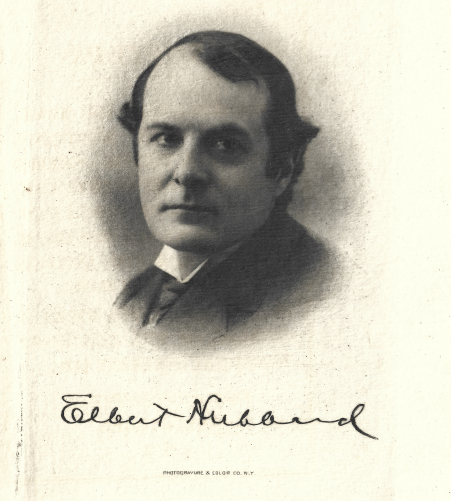
A Mezzotint of Elbert Hubbard.
Last page of Little Journeys: English Authors: William Morris
He admitted his “double life…makes the man a liar” (Champney 49). This self-appointed “liar” label haunted, yet in many ways, ironically boosted Hubbard’s career.
Hubbard’s tumultuous personal life and his resentment towards Evangelism whose “entire intent…is to destroy his self-confidence—to make him think less of himself” (16), towards professors who refused to take him seriously, and towards literary gatekeepers, all seemed to coalesce into an unbearable restlessness; a restlessness that drove him to take an unplanned trip to Europe. While we know for certain that Hubbard did manage to get a tour of Kelmscott, skeptics have questioned Hubbard’s claims to have met Morris during this trip (Johnson).
However, there is no doubt that this trip did inspire Hubbard to write Little Journeys to the Homes of English Authors: William Morris. In this book, he praised the details, beauty, and comfort of Morris’s chair, “the one in which I rested at Kelmscott House—broad, deep, massive, upholstered with curled hair, & covered with leather that would delight a book binder” (Hubbard 11). His description of Morris’s chair snowballs into an embellished account of meeting Morris, whom he recognized immediately because who “could mistake that great shaggy head, the tangled beard, and frank, open-eyed look of boyish animation? [He] greeted me as if we always had known each other…and piles of Chaucer proof led straight to old Professor Childs of Harvard” (Hubbard 18). Throughout this edition, Hubbard praises, worships, and even deifies Morris. Whether or not his acclaimed meeting of Morris was true or just a fanciful rendition of a supposed arts and crafts hero, there is no doubt that his visit to Kelmscott left a major impression upon Hubbard and steered his life’s mission.
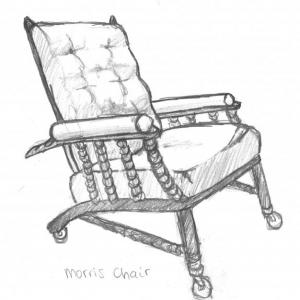
The Morris Chair that Hubbard describes, sketched by Adriana Culverhouse
Roycrofters
Hubbard returned to the states but not before buying “a hand press, type, and accessories…and Roycroft took shape in Hubbard’s barn…Kelmscott Press was fresh in Hubbard’s mind and he set to work on a hand wrought, handmade, rough binding, arty [books] because…Morris was printing books that were beautiful as books; books to be looked at as much as read” (Champney 58). Hubbard eventually transformed Roycrofters into “one third business establishment, one third university, and one third horse ranch, with just a touch of the monastic” (Champney 64). This establishment allowed him to rightfully honor Kelmscott and Morris’s Arts and Crafts style.
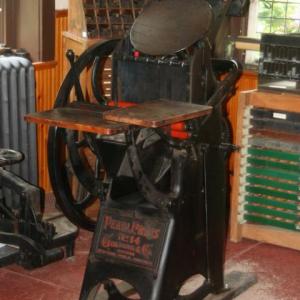
Hubbard’s Hand Press
Hubbard went on to publish an unprecedented 180 Little Journeys series (of which we get Hubbard-perspective biographies on many great people who are Painters, English Authors, Great Reformers, the Great, American Authors, Great Scientists, etc.) which also vary in the amount of hand-bound, hand-published editions—some of which only have less than a hundred copies, whereas others, like the William Morris edition, have upwards of 925 copies.
After Hubbard’s death in 1915, the Roycrofters set out to publish a memorial edition: Little Journeys to the Homes of the Great Elbert Hubbard.
Little Journeys series
After a successful career selling soap, after applying to Harvard but being turned away, and after many publishers refused to accept his novels, in 1894 Putnam agreed to print Hubbard’s No Enemy; a story about an idle rich man. Putman then asked to meet Hubbard. It was at that meeting Hubbard pitched the Little Journeys pamphlets; pamphlets Hubbard had personally financed the printing by Pendennis Press. “Putnam…published twelve of the [Little Journeys] booklets” (Champney 54). The Little Journeys series boosted Hubbard’s career and may have even helped him achieve his goals of reaching “a larger audience” (Champney 54), appealing to “lovers of book…people who never knew books before” (Champney 84), and especially rebelling “against publishing [and]…the literary establishment (Champney 54).
Little Journeys adorned the shelves of public libraries, the studies of affluent business tycoons, and the mantles of working-class homes. Anyone could understand these biographies. They invited everyone, not just cloistered scholars, to read about world leaders, discuss political, religious, and philosophical dogma, and challenge ideas and beliefs that had previously been inaccessible to many people. Their success as ‘beautiful books’ (Digital Libraries) supports Hubbard’s legacy as the father of the Arts and Crafts movement in the US–a movement that continues to inspire many Americans today. Many editions in this series are beautiful, are filled with hand-painted pictorials, and include Mezzotints. However, this Little Journeys to the Homes of English Authors: William Morris is significant; it describes William Morris, the man who inspired Hubbard’s art.
This Edition
Little Journeys to the Homes of English Authors: William Morris is beautiful and represents Hubbard’s attempt to imitate Morris’s exquisite bookbinding, printing, and publishing techniques. The hand-painted pictorials, the archaic ligature Bookman-like fonts, the hand-made paper and vellums, and the portraits—a lithograph of Morris and a Mezzotint of Hubbard, all try “to resurrect the lost art of making books'' (Hubbard 24); a resurrection that is eloquently detailed at the very end of this edition as Hubbard describes Morris’s art as exemplifying “a loving, religious service…a clean, wholesome, manly life” (Hubbard 24). The artwork entices you to turn the page; the political stance is obvious, and the humor is funny but also, at times, malicious. This booklet also includes a slew of comments and verbal jabs that ridicule Morris’s friends and enemies and uses powerful descriptions of Morris, e.g., “Lord” and “Master” that praise, expound, even glorify Morris. A unique perspective through the eyes of the bizarre, eccentric, and even genius Hubbard.
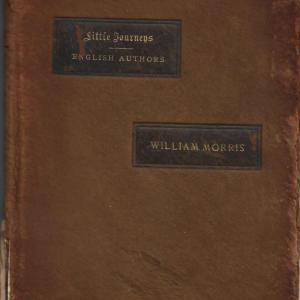
Cover
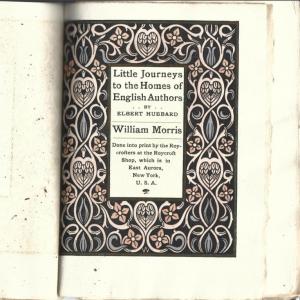
Illuminated Title Page

Signature page with watermark, hand-painted pictorials, and Archaic
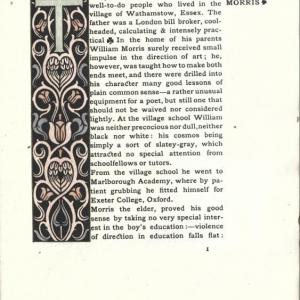
font of Hubbard’s Little Journeys English Authors: William Morris.
Hubbard meticulously attempts to replicate Morris in every Little Journeys booklet. However, this edition stands out because it was Morris that inspired Hubbard to create and publish these beautiful books. Every Little Journeys book pays tribute to William Morris and reflects the beauty of the Arts and Crafts style but only the essence of this edition reflects Hubbard’s genuine passion and commitment to Morris’s life, work, and art.
Conclusion
Elbert Hubbard was a quagmire of contradictions. He had an affair with a New Woman even though he believed this relationship labeled him a liar; he wrote and circulated a blockbuster, an anti-socialist article titled A Message to Garcia, even though in this edition he passionately supported William Morris’s socialist agenda; he mass-marketed the Philistine—a cheap tabloid stuffed with advertisements, half-truths, and lies, even though many of his beautiful hand-printed Little Journeys adorned the shelves of public libraries, the studies of affluent business tycoons, and the mantels of working-class homes.
Hubbard passionately built Roycrofters to honor Kelmscott; he included stunning archaic font, lithographs, and hand-painted pictures in his Little Journeys booklets; he passionately defended Morris’s socialist agenda; and he gloriously detailed the Arts and Crafts movement. However, he also profited from big business advertisements, spread malicious half-truths, and, according to May Morris, was an “obnoxious imitator of my dear father.” (Champney 119). In the end, the final minutes of Hubbard’s life so eloquently reflects the controversies, the half-truths, and the honor and anguish both dignitaries and the middle-class Americans felt towards Elbert Green Hubbard.
In 1915, Elbert and Alice booked passage on the Lusitania, even though the German Embassy warned passengers to cancel their tickets and to avoid all ships sailing near the war zone. Hubbard “pooh-poohed any talk of danger...[he] told reporters that he didn’t know but what the Kaiser would be willing to talk to him and that such a meeting might even lead toward peace” (Champney 195). Hubbard, and his wife Alice, sank with the Lusitania. Only eighteen minutes passed between the torpedo hitting the ship and the ship plunging beneath the surface. However, several accounts describe Elbert and Alice as calm, as ignoring the chaos, and as one survivor remembered seeing “them go into a cabin and close the door” (Champney 195). Even though “very little is known about the actions of the Hubbards in the eighteen minutes of chaos...[the] final issue of the Philistine treated this as a deliberate self-sacrifice" (Champney 195). The man whom many claimed promoted William Morris’s Art and was the Father of the American Arts and Crafts movement, became a martyr as he plunged into the depths of the ocean, along with the Lusitania.
Does Hubbard deserve to be honored as The Father of the American Arts and Crafts Movement? Our edition cannot unequivocally answer this question. However, after reading it closely, admiring its physicality, and interpreting Hubbard’s prose, you can decide if Hubbard was a shrewd businessperson, an unethical publisher, a megalomaniac, or even possibly a genius. However, there is no doubt that Elbert Green Hubbard was an enigma, that he loved controversy, and that he did impact the reception of William Morris’s Arts and Crafts movement in this country.
Works Cited
Ashbee, F. (2002). Janet Ashbee & Elbert Hubbard in East Aurora. Style 1900, 15(2).
Bradley, Ian. William Morris and his world, London, Thames and Hudson Ltd., 1978. (Image of the Morris Chair).
Champney, Freeman. Art & Glory: The Story of Elbert Hubbard, New York: Crown Publishers, Inc., 1968.
Digital Libraries, Morris Exhibit, Influence in Private Press: Elbert Hubbard, William Morris - Elbert Hubbard (uc.edu).
Duffus, R. L. (1940, February 25). Elbert Hubbard of Roycroft: A Biography of the Various Sided Man of Letters and Affairs Whose "Message to Garcia" Was the 40,000,000-Copy Best-Seller of Its Day. New York Times, p. 81.
Hricik, David, “Professor Hricik’s chronology of Things Roycraftie,” Professor David Hrick, 2004. http://www.hricik.com/Roycroft/roycroftlinks.html
Hubbard, Elbert. Little Journeys: William Morris, East Aurora, New York: Roycroft Shop, 1900.
Image of Roycroft printing press: https://www.alamy.com/stock-photo/roycroft-shop.html
Johnson, Bruce E. "More than words." Country Living, vol. 20, no. 2, Feb. 1997, pp. 38+. Gale Academic OneFile, link.gale.com/apps/doc/A19192469/AONE?u=greenbay&sid=bookmark-AONE&xid=c6ba3d1a. Accessed 10 Apr. 2022.
Kauffman, Bill. "Arts & Crafts Apostle." The American Enterprise, vol. 10, no. 1, Jan. 1999, p. 76. Gale Academic OneFile, link.gale.com/apps/doc/A53542803/AONE?u=greenbay&sid=bookmark-AONE&xid=fee897f0. Accessed 4 Apr. 2022.
Luther College, Preus Library, Roycroft Collection. https://www.luther.edu/library/about/collections/special/roycroft/
Myer, Phillip, Craftsman Bungalow, Arts and Crafts Home Furnishing Builder. http://www.thecraftsmanbungalow.com/craftsman-spotlight-ragsdale/
